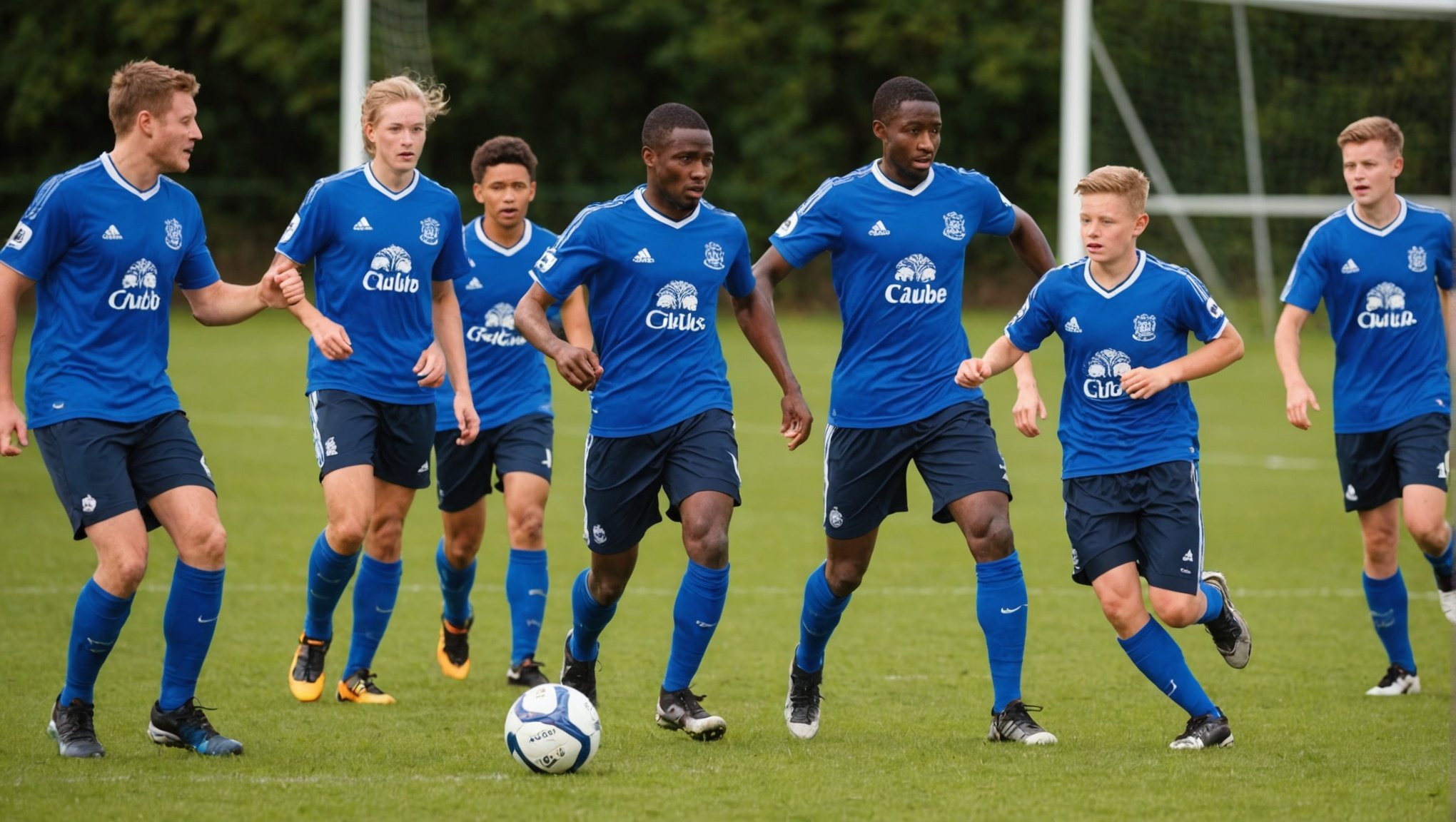Unlocking Community Engagement: Strategies for UK Sports Clubs to Boost Participation Through Outreach Programs
The Importance of Community Engagement in Sports
Community engagement is the heartbeat of any successful sports club. It is the glue that binds the club to its local community, fostering a sense of belonging and loyalty among its members and supporters. In the UK, sports clubs are increasingly recognizing the value of outreach programs in boosting participation, improving community relations, and enhancing the overall impact of their activities.
“Community engagement is not just about getting people to watch games; it’s about creating a lasting bond between the club and the community,” says Tom Bosworth, Olympic race walker and British record holder, who has been involved in various community outreach programs[1].
Topic to read : Building a Culture of Respect and Integrity in UK Sports Clubs: Strategies for Success
Understanding Local Needs and Leveraging Partnerships
To effectively engage with the local community, sports clubs must first understand the needs and aspirations of the people they serve. This involves conducting thorough research and engaging in dialogue with local stakeholders.
Community Research and Feedback
- Conduct surveys and focus groups to understand the interests and needs of local residents.
- Collaborate with local schools, community centers, and other organizations to gather insights.
- Use social media and other digital platforms to engage with the community and gather feedback.
Local Partnerships
- Partner with local authorities to access resources and funding.
- Collaborate with national governing bodies for sports to gain expertise and support.
- Work with local businesses to secure sponsorships and community support.
For example, StreetGames, an organization dedicated to transforming the lives of young people through sport, works closely with its network members and partners to deliver sport and physical activity programs tailored to the needs of underserved communities[3].
In the same genre : Engaging the Next Generation: Strategies for UK Bowling Leagues to Connect with Youth through Interactive Technology
Doorstep Sport: Bringing Sport to the Community
One of the most effective strategies for community engagement is the “Doorstep Sport” approach, pioneered by StreetGames. This approach is underpinned by the “five rights”: sport delivered at the right time, in the right place, in the right style, by the right people, and at the right price.
Key Components of Doorstep Sport
- Right Time: Ensuring that sport and physical activity programs are available when they are most needed by the community.
- Right Place: Delivering programs in locations that are easily accessible to the community.
- Right Style: Offering programs that are appealing and relevant to the community.
- Right People: Ensuring that programs are delivered by qualified and empathetic staff.
- Right Price: Making programs affordable and accessible to all members of the community.
This approach has been highly successful in engaging young people from low-income, underserved communities in sport and physical activity, thereby improving their physical, mental, and social well-being[3].
Community Involvement and Local Talent
Incorporating community involvement and highlighting local talent are crucial strategies for boosting community pride and engagement.
Community Events
- Organize charity matches, fundraising events, and other community-focused activities.
- Partner with local schools and organizations to create events that resonate with the community.
- Use major sporting events, such as the Commonwealth Games, as opportunities to engage the community through ticket giveaways, volunteering opportunities, and training programs.
Highlighting Local Talent
- Feature local musicians, artists, or athletes during sporting events.
- Host local talent shows or competitions to celebrate community talent.
- Provide opportunities for local youth to participate in sports clinics and training sessions.
For instance, UK basketball clubs like the Leicester Riders have significantly boosted fan involvement by organizing local basketball clinics and engaging with schools. This approach not only increases the fan base but also fosters loyalty and support within the community[4].
Personalized Fan Interaction and Digital Engagement
In today’s digital age, personalized fan interaction and digital engagement are essential for maintaining a strong connection with the community.
Personalized Communication
- Use data analytics to tailor messages and content to individual fan preferences.
- Send personalized updates, offers, and news to ticket holders.
- Implement loyalty programs that reward fans for their engagement.
Digital Platforms
- Utilize social media to maintain a constant dialogue with the audience.
- Create mobile apps to deliver customized content, such as match highlights and player stats.
- Use live updates and interactive content to keep fans engaged even when games are not happening.
The London Lions, for example, have seen a substantial increase in online followers and game attendance by implementing a digital-first strategy that includes interactive content and live updates[4].
The Role of Government and National Lottery Funding
Government support and national lottery funding play a critical role in enabling sports clubs to implement effective outreach programs.
Government Initiatives
- The UK government has launched various initiatives to promote physical activity and community engagement through sport.
- Programs like the “Unlocking the Potential” report propose a strategic vision for harnessing the sport, recreation, and physical activity sector to improve national well-being[1].
National Lottery Funding
- The National Lottery has been a significant source of funding for community sports projects.
- Funding from the National Lottery has enabled sports clubs to develop infrastructure, hire staff, and deliver community programs.
“Government support and national lottery funding are vital for us to deliver our programs effectively,” notes a spokesperson from StreetGames. “These funds help us reach more young people and make a meaningful impact in their lives”[3].
Mental Health and Well-being
Sports clubs also play a crucial role in promoting mental health and well-being within their communities.
Mental Health Initiatives
- Many sports clubs have signed the Mental Health Charter for Sport and Recreation, committing to support mental health initiatives.
- Clubs can organize mental health awareness events, provide counseling services, and integrate mental health support into their programs.
Physical Activity and Mental Health
- Physical activity has been proven to have a positive impact on mental health.
- By encouraging people to be physically active, sports clubs can contribute to improving mental well-being in their communities.
A report by the Sport and Recreation Alliance highlights the significant impact of the Mental Health Charter on driving improvement across the sector and ensuring sports governing bodies have a consistent approach to managing mental health[1].
Successful Case Studies and Best Practices
Several UK sports clubs have set benchmarks with their innovative community engagement strategies.
Leicester Riders
- Organized local basketball clinics and engaged with schools to create a strong community presence.
- Increased fan base and fostered loyalty and support through community-focused initiatives[4].
London Lions
- Implemented a digital-first strategy using social media to maintain a constant dialogue with the audience.
- Saw a substantial increase in online followers and game attendance through interactive content and live updates[4].
StreetGames
- Delivered Doorstep Sport programs tailored to the needs of underserved communities.
- Transformed the lives of young people through sport and physical activity, improving their physical, mental, and social well-being[3].
Practical Insights and Actionable Advice
For sports clubs looking to boost community engagement, here are some practical insights and actionable advice:
Understand Your Community
- Conduct thorough research to understand the needs and aspirations of your local community.
Build Strong Partnerships
- Collaborate with local authorities, national governing bodies, and local businesses to secure resources and support.
Deliver Relevant Programs
- Ensure that your programs are delivered at the right time, in the right place, in the right style, by the right people, and at the right price.
Leverage Digital Platforms
- Use social media and mobile apps to maintain a constant dialogue with your audience and deliver personalized content.
Focus on Mental Health
- Integrate mental health support into your programs and organize awareness events to promote mental well-being.
By following these strategies, sports clubs can unlock the full potential of community engagement, fostering a stronger, more supportive community that benefits everyone involved.
Community engagement is at the heart of what makes sports clubs successful and impactful. By understanding local needs, leveraging partnerships, delivering relevant programs, and leveraging digital platforms, sports clubs can create a lasting bond with their communities. With the support of government initiatives and national lottery funding, and a focus on mental health and well-being, sports clubs can transform lives and communities, making sport a right rather than a privilege for all.
| Strategy | Description | Example |
|---|---|---|
| Community Research | Conduct surveys and focus groups to understand local needs. | StreetGames’ research on underserved communities[3]. |
| Local Partnerships | Collaborate with local authorities and businesses. | Leicester Riders’ partnership with local schools[4]. |
| Doorstep Sport | Deliver sport at the right time, place, style, by the right people, and at the right price. | StreetGames’ Doorstep Sport programs[3]. |
| Highlighting Local Talent | Feature local musicians, artists, or athletes during events. | UK basketball clubs featuring local talent during games[4]. |
| Personalized Fan Interaction | Use data analytics to tailor messages and content. | London Lions’ digital-first strategy[4]. |
| Government and National Lottery Funding | Utilize funding to support community programs. | StreetGames’ funding from the National Lottery[3]. |
| Mental Health Initiatives | Integrate mental health support into programs. | Mental Health Charter for Sport and Recreation[1]. |
Table: Strategies for Community Engagement
| Strategy | Description | Example |
|---|---|---|
| Community Research | Conduct surveys and focus groups to understand local needs. | StreetGames’ research on underserved communities[3]. |
| Local Partnerships | Collaborate with local authorities and businesses. | Leicester Riders’ partnership with local schools[4]. |
| Doorstep Sport | Deliver sport at the right time, place, style, by the right people, and at the right price. | StreetGames’ Doorstep Sport programs[3]. |
| Highlighting Local Talent | Feature local musicians, artists, or athletes during events. | UK basketball clubs featuring local talent during games[4]. |
| Personalized Fan Interaction | Use data analytics to tailor messages and content. | London Lions’ digital-first strategy[4]. |
| Government and National Lottery Funding | Utilize funding to support community programs. | StreetGames’ funding from the National Lottery[3]. |
| Mental Health Initiatives | Integrate mental health support into programs. | Mental Health Charter for Sport and Recreation[1]. |
Detailed Bullet Point List: Key Strategies for Community Engagement
-
Conduct Community Research:
-
Conduct surveys and focus groups to understand the interests and needs of local residents.
-
Collaborate with local schools, community centers, and other organizations to gather insights.
-
Use social media and other digital platforms to engage with the community and gather feedback.
-
Build Local Partnerships:
-
Partner with local authorities to access resources and funding.
-
Collaborate with national governing bodies for sports to gain expertise and support.
-
Work with local businesses to secure sponsorships and community support.
-
Implement Doorstep Sport:
-
Ensure sport and physical activity programs are delivered at the right time.
-
Deliver programs in locations that are easily accessible to the community.
-
Offer programs that are appealing and relevant to the community.
-
Ensure programs are delivered by qualified and empathetic staff.
-
Make programs affordable and accessible to all members of the community.
-
Highlight Local Talent:
-
Feature local musicians, artists, or athletes during sporting events.
-
Host local talent shows or competitions to celebrate community talent.
-
Provide opportunities for local youth to participate in sports clinics and training sessions.
-
Use Personalized Fan Interaction:
-
Use data analytics to tailor messages and content to individual fan preferences.
-
Send personalized updates, offers, and news to ticket holders.
-
Implement loyalty programs that reward fans for their engagement.
-
Leverage Digital Platforms:
-
Utilize social media to maintain a constant dialogue with the audience.
-
Create mobile apps to deliver customized content, such as match highlights and player stats.
-
Use live updates and interactive content to keep fans engaged even when games are not happening.
-
Utilize Government and National Lottery Funding:
-
Access funding from government initiatives and the National Lottery to support community programs.
-
Use funding to develop infrastructure, hire staff, and deliver community programs.
-
Focus on Mental Health Initiatives:
-
Sign the Mental Health Charter for Sport and Recreation to commit to supporting mental health initiatives.
-
Organize mental health awareness events and provide counseling services.
-
Integrate mental health support into your programs to promote mental well-being in the community.













